There has been a good movement of warblers through central Ohio the past few days. Lots of diversity, and decent numbers of many species. This'll be our last substantial pulse of migrant warblers for the year. Come the second week in October there is typically a marked dropoff in most species.
Sparked by various reports today, I ran out for a brief visit to our little habitat patch in urban Columbus, just outside my office. In no time, I saw American Redstart, Common Yellowthroat, and the above, a Nashville Warbler, Oreothlypis rufacapilla.
Nashvilles have a suite of three instantly noticeable characters: gray head, yellow underparts including the throat, and a bold white eye ring. The latter field mark sometimes causes them to be confused with a much rarer and altogether different beast, the Connecticut Warbler. In fact, I heard reports of as many as a half-dozen Connecticuts at a local park today. Hmmmm...
Anyway, this bird's distinctly Tennesseean name stems from the Father of Ornithology himself, Alexander Wilson, who first collected this species near Nashville in 1811. It's not a very descriptive name, as Nashville Warblers don't breed anywhere near the Volunteer State - it is primarily a bird of boreal forest zones in the northern U.S. and Canada. They prefer scrubby successional growth as nesters, and this is THE common warbler in the young jack pine colonies where Kirtland's Warblers breed.
Nashville Warblers have a fascinating breeding distribution. There are the eastern birds, such as in my photos. And then there is the western "Calaveras Warbler", as it was once called. This western population breeds in the far northwestern U.S. and adjacent Canada, and is widely separated from the eastern breeding population. The westerners are given subspecific recognition: Oreothlypis rufacapilla ridgwayi. The trinomial ridgwayi recognizes ornithologist Robert Ridgway, who first found the "Calaveras Warbler" in Nevada in 1868.
The majority of Nashville Warblers travel to central and southern Mexico for the winter, and that's probably where this bird will end up in a few weeks. Today, though, he gleaned insects from our box-elder trees and brightened my afternoon.



No comments:
Post a Comment